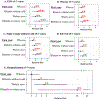Infant rhinitis and watery eyes predict school-age exercise-induced wheeze, emergency department visits and respiratory-related hospitalizations
- PMID: 29508714
- PMCID: PMC6456909
- DOI: 10.1016/j.anai.2017.11.024
Infant rhinitis and watery eyes predict school-age exercise-induced wheeze, emergency department visits and respiratory-related hospitalizations
Abstract
Background: Rhinitis and conjunctivitis are often linked to asthma development through an allergic pathway. However, runny nose and watery eyes can result from nonallergic mechanisms. These mechanisms can also underlie exercise-induced wheeze (EIW), which has been associated with urgent medical visits for asthma, independent of other indicators of asthma severity or control.
Objective: To test the hypothesis that rhinitis or watery eyes without cold symptoms (RWWC) in infancy predict development of EIW and urgent respiratory-related medical visits at school age, independent of seroatopy.
Methods: Within a prospective birth cohort of low-income, urban children (n = 332), RWWC was queried during the first year of life. Relative risks (RRs) for EIW, emergency department (ED) visits, and hospitalizations for asthma and other breathing difficulties at 5 to 7 years of age were estimated with multivariable models. Seroatopy was determined at 7 years of age.
Results: Infant RWWC was common (49% of children) and predicted school-age EIW (RR, 2.8; P < .001), ED visits (RR, 1.8; P = .001), and hospitalizations (RR, 9.8; P = .002). These associations were independent of infant wheeze. They were also independent of birth order, an indicator of increased risk of exposure to viruses in infancy, and infant ear infections, an indicator of sequelae of upper airway infections. The association between infant RWWC and ED visits at 5 to 7 years of age was attenuated (RR, 1.2; P = .23) when EIW at 5 to 7 years of age was included in the model, suggesting EIW mediates the association. Adjustment for seroatopy did not diminish the magnitudes of any of these associations.
Conclusion: These findings suggest a nonallergic connection between infant nonwheeze symptoms and important consequences of urban respiratory health by school age through EIW.
Copyright © 2017 American College of Allergy, Asthma & Immunology. Published by Elsevier Inc. All rights reserved.
Conflict of interest statement
Figures






Similar articles
-
Report of prenatal maternal demoralization and material hardship and infant rhinorrhea and watery eyes.Ann Allergy Asthma Immunol. 2020 Oct;125(4):399-404.e2. doi: 10.1016/j.anai.2020.07.016. Epub 2020 Jul 22. Ann Allergy Asthma Immunol. 2020. PMID: 32711029 Free PMC article.
-
Association of exercise-induced wheeze and other asthma symptoms with emergency department visits and hospitalizations in a large cohort of urban adolescents.Respir Med. 2018 Feb;135:42-50. doi: 10.1016/j.rmed.2018.01.005. Epub 2018 Jan 10. Respir Med. 2018. PMID: 29414452 Free PMC article.
-
Exercise-induced wheeze, urgent medical visits, and neighborhood asthma prevalence.Pediatrics. 2013 Jan;131(1):e127-35. doi: 10.1542/peds.2012-1072. Epub 2012 Dec 17. Pediatrics. 2013. PMID: 23248227 Free PMC article.
-
Low-grade disease activity in early life precedes childhood asthma and allergy.Dan Med J. 2016 Aug;63(8):B5272. Dan Med J. 2016. PMID: 27477800 Review.
-
Epidemiology of asthma and recurrent wheeze in childhood.Clin Rev Allergy Immunol. 2002 Feb;22(1):33-44. doi: 10.1007/s12016-002-0004-z. Clin Rev Allergy Immunol. 2002. PMID: 11803801 Review.
Cited by
-
Neonatal rhinorrhea, heart rate variability, and childhood exercise-induced wheeze.J Allergy Clin Immunol Glob. 2023 Jul 19;2(4):100149. doi: 10.1016/j.jacig.2023.100149. eCollection 2023 Nov. J Allergy Clin Immunol Glob. 2023. PMID: 37781655 Free PMC article.
-
Trajectory analysis of rhinitis in a birth cohort from lower-income New York City neighborhoods.J Allergy Clin Immunol. 2024 Jul;154(1):111-119. doi: 10.1016/j.jaci.2023.11.919. Epub 2023 Dec 16. J Allergy Clin Immunol. 2024. PMID: 38104949 Free PMC article.
-
Associations between Parasympathetic Activity in the Month after Birth and Wheeze at Age 2-3 Years.Am J Respir Crit Care Med. 2018 Aug 15;198(4):532-534. doi: 10.1164/rccm.201712-2591LE. Am J Respir Crit Care Med. 2018. PMID: 29787287 Free PMC article. No abstract available.
-
Report of prenatal maternal demoralization and material hardship and infant rhinorrhea and watery eyes.Ann Allergy Asthma Immunol. 2020 Oct;125(4):399-404.e2. doi: 10.1016/j.anai.2020.07.016. Epub 2020 Jul 22. Ann Allergy Asthma Immunol. 2020. PMID: 32711029 Free PMC article.
-
Increased Heart Rate Variability Response Among Infants with Reported Rhinorrhea and Watery Eyes: A Pilot Study.J Asthma Allergy. 2021 Nov 9;14:1349-1354. doi: 10.2147/JAA.S329347. eCollection 2021. J Asthma Allergy. 2021. PMID: 34785908 Free PMC article.
References
-
- Rzehak P, Schoefer Y, Wichmann HE, Heinrich J. A prospective study on the association between hay fever among children and incidence of asthma in East Germany. Eur J Epidemiol. 2008;23(1):17–22. - PubMed
-
- Shaaban R, Zureik M, Soussan D, et al. Rhinitis and onset of asthma: a longitudinal population-based study. Lancet. September 20 2008;372(9643):1049–1057. - PubMed
-
- Arshad SH, Kurukulaaratchy RJ, Fenn M, Waterhouse L, Matthews S. Rhinitis in 10-year-old children and early life risk factors for its development. Acta Paediatr. 2002;91(12):1334–1338. - PubMed
-
- Gotshall RW. Exercise-induced bronchoconstriction. Drugs. 2002;62(12):1725–1739. - PubMed
-
- Hallstrand TS, Curtis JR, Koepsell TD, et al. Effectiveness of screening examinations to detect unrecognized exercise-induced bronchoconstriction. The Journal of pediatrics. September 2002;141(3):343–348. - PubMed
Publication types
MeSH terms
Substances
Grants and funding
LinkOut - more resources
Full Text Sources
Other Literature Sources

